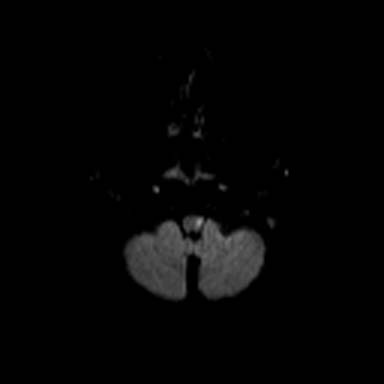Return to: Unilateral Laryngeal Paralysis or Vocal Cord Paralysis
See also: Tapia Syndrome paralysis of vagus and hypoglossal nerves after intubation
Definitions
- Wallenberg syndrome = Lateral medullary syndrome (aka Posterior Inferior Cerebellar Artery (PICA) syndrome)
- Constellation of neurologic symptoms due to injury to the lateral part of the medulla in the brain
- Sensory deficits affecting the trunk (torso) and extremities on the opposite side of the infarction
- loss of pain and temperature sensation on the contralateral (opposite) side of the body
- Sensory deficits affecting the face and cranial nerves on the same side with the infarct.
- loss of pain and temperature sensation on the ipsilateral (same) side of the face.
- Sensory deficits affecting the trunk (torso) and extremities on the opposite side of the infarction
- Constellation of neurologic symptoms due to injury to the lateral part of the medulla in the brain
- Clinical symptoms include difficulty swallowing, slurred speech, facial pain, vertigo, Horner syndrome, and possibly palatal myoclonus
- Otolaryngological features include dysphonia, dysphagia and nasal regurgitation related to:
- Ipsilateral vocal fold paralysis
- Palatal and pharyngeal paresis
- May also be associated with obstructive sleep apnea and airway obstruction (Vaidyanathan 2007)
- Otolaryngological features include dysphonia, dysphagia and nasal regurgitation related to:
- A complete Wallenberg syndrome is not common with key factors in clinical diagnosis being 'crossed hemiparesis or hemianesthesia' indicating a brainstem lesion
- Estimated 60,000 new cases in the United States each year with usually a better outcome - with most common sequelae being gait instability and most patients returning to satisfactory activities of daily living (Lui 2019).
Etiology
- Most commonly caused by atherothrombotic occlusion of the vertebral artery (then posterior inferior cerebellar artery and least often the medullary arteries.
- Risk factors
- Hypertension is most common risk factor with other causes
- Vertebral artery dissection associated with:
- History of trauma, neck
- Underlying collagen vascular disease
Affected Anatomy
- Involvement of nucleus ambiguus: dysphagia, dysphonia and dysarthria
- Laryngeal, pharyngeal and palatal paralysis
- Involvement of trigeminal nucleus: ipsilateral facial and corneal anesthesia
- Involvement of spinothalamic tract: loss of pain and temperature sensation to the opposite side of body
- Involvement of cerebellum: ataxia
- Involvement of hypothalamic fibers: sympathetic nervous system abnormal c/w Horners syndrome
- Involvement of Deiters' nucleus and other vestibular nuclei: nystagmus and vertigo
- Involvement of central tegmental tract: palatal myoclonus
- Radiology (MRI)
Trigeminal Trophic Syndrome
May be associated with Wallenberg's syndrome and is a rare cause of facial ulcerations associated with injury to the trigeminal nerve (Parimalam 2014) with the syndrome comprised of triad of:
- Anesthesia
- Paresthesia
- Secondary persistent or recurrent facial ulceration
First described by Wallenberg in 1901 (cutaneous ulceration in the trigeminal dermatome)
References
Parimalam Kumar, Jayakar Thomas Trigeminal Trophic Syndrome Indian J Dermatol. 2014 Jan-Feb; 59(1): 75–76. doi: 10.4103/0019-5154.123506
Rashid RM, Khachemoune A. Trigeminal trophic syndrome. J Eur Acad Dermatol Venereol. 2007 Jul;21(6):725-31. doi: 10.1111/j.1468-3083.2007.02250.x. PMID: 17567297.
Loveman AB. An unusual dermatosis following section of the fifth cranial nerve. Arch Dermatol Syph. 1933;28:369–75
Vaidyanathan S1, Capper R, Chadha D. Stridor: an unusual presentation of lateral medullary syndrome.J Laryngol Otol. 2007 Jul;121(7):e9. Epub 2007 Mar 19.
Lui F, Anilkumar AC. Wallenberg Syndrome. [Updated 2019 Jan 11]. In: StatPearls [Internet]. Treasure Island (FL): StatPearls Publishing; 2019 Jan-.Available from: https://www-ncbi-nlm-nih-gov.proxy.lib.uiowa.edu/books/NBK470174/
Ruedrich ED, Chikkannaiah M, Kumar G.Wallenberg's lateral medullary syndrome in an adolescent.Am J Emerg Med. 2016 Nov;34(11):2254.e1-2254.e2. doi: 10.1016/j.ajem.2016.05.022. Epub 2016 May 12.


